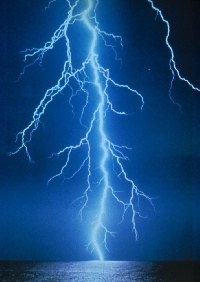
There are many ancient legends regarding the origin of thunder
Where does thunder come from? There are many ancient legends regarding the origin of this natural weather occurence. The early Anglo-Saxons first worshiped a thunder god named Thunor. It is believed that the Vikings and Norse later derived the name for their God Thor, from ancient stories from these early Anglo Saxon tribes.
According to early Norse legends, the god Thor rode through the heavens on chariot pulled by goats. Lighting flashed whenever Thor threw his hammer, and thunder crashed as his hammer tumbled against the clouds. Thunder and lightning were also believed to be the result of Thor fighting in the sky with his enemies, such as Jormungand the Midgard Serpent.
Even in more recent cultures, such as the Native American tribes of the Southwestern United States, people sought answers to mysterious natural occurrences such as thunder and lighting. In an effort to de-mystify timeless questions such as where does thunder come from, Native Americans wove legends about Grandfather Thunder and Grandmother Moon. According to these legends, when Grandfather Thunder was neglected, he became angry and bitter, crying out in a voice that rumbled and shook the heavens and earth, and shot lightening arrows at the earth, killing people, burning houses and shattering trees.
~
Today, ancient stories and legends have given way to an age of discovery and scientific explanations. When children ask the question, where does thunder come from? We may still feed their imaginations with the magical stories and legends of our ancestors. However, scientists and meteorologists have offered us more reasonable and realistic explanations for thunder and lighting.
During a storm, thunder is caused by the rapid expansion and contraction of the air surrounding a lightning bolt. The incredible heat of a lightning bolt (nearly 50,000 degrees Fare height) causes the air around the bolt to become super heated. Thus, the air suddenly expands, in less than a fraction of a second. However, the air cannot stay super heated very long. The heat dissipates quickly through the air, causing compression waves that we hear as thunder.
Because the speed of light travels considerably faster than the speed of sound, the visual image of light from a lightning bolt reaches us much faster than the sound of the heated compression waves it creates.
In fact, it is easy enough to determine how far away a lightning storm is by counting the seconds from when you see a flash of lighting to when you hear the first clap of thunder. After counting the number of seconds in this delay, divide the number by five, and you will have a rough estimate for how many miles away the storm is. In other words, every five seconds equals about one mile. This equation can vary slightly depending on altitude.
Often, thunder can seem to rumble and echo all around us at once. During these times, it can be difficult to determine where does thunder come from, and what direction is a storm moving? It is helpful to understand that there are logical reasons for this rumbling sound.
First off, a lightning bolt is not usually a straight line. On average, a lightning bolt is over four miles long, branching out in many different directions through the sky and atmosphere. This causes a multitude of compression waves that all reach our ears at different times.
Secondly, the compression waves of a thunder clap will bounce off the clouds, the ground, and other objects such as mountains, or water, much like your voice echoes in a canyon or large auditorium. These compression wave echoes will grow louder and softer, often echoing and repeating. This echoing constitutes the rumbles of thunder that we hear.
The next time someone asks you, where does thunder come from, consider sharing the ancient legends of early human civilizations, prior to offering a contemporary, scientific explanation.

